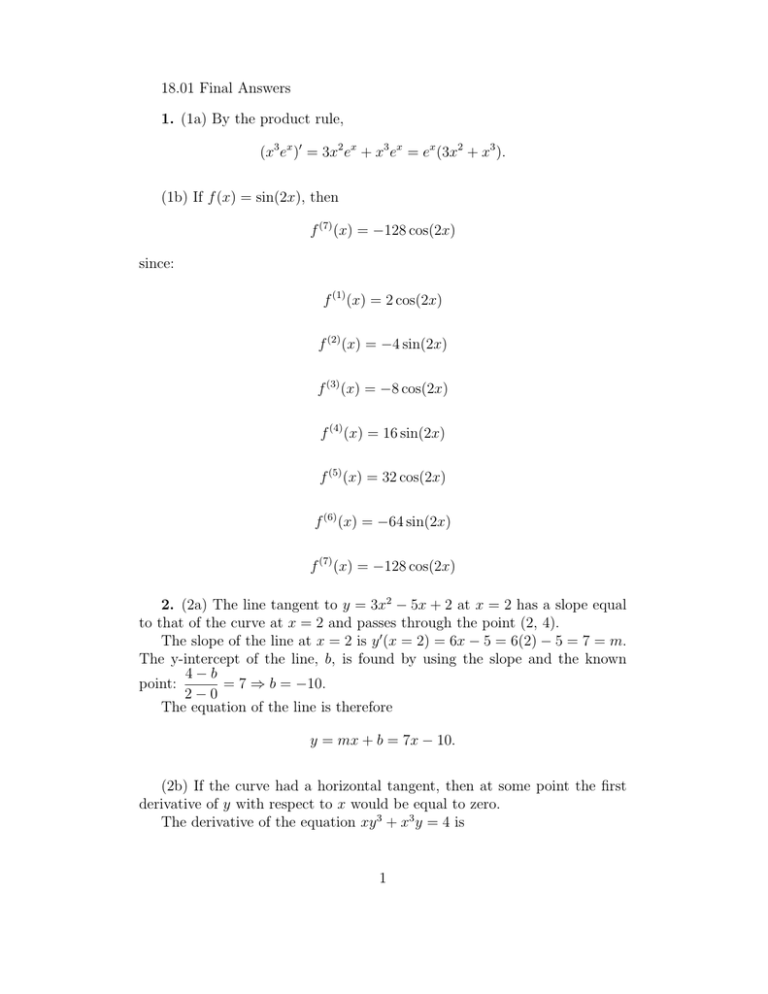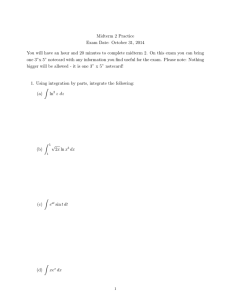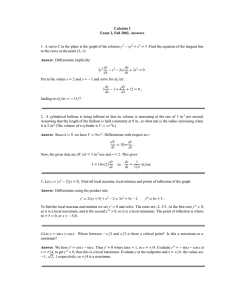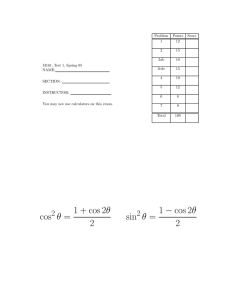18.01 Final Answers 1. (1a) By the product rule, (x e
advertisement

18.01 Final Answers 1. (1a) By the product rule, (x3 ex )0 = 3x2 ex + x3 ex = ex (3x2 + x3 ). (1b) If f (x) = sin(2x), then f (7) (x) = −128 cos(2x) since: f (1) (x) = 2 cos(2x) f (2) (x) = −4 sin(2x) f (3) (x) = −8 cos(2x) f (4) (x) = 16 sin(2x) f (5) (x) = 32 cos(2x) f (6) (x) = −64 sin(2x) f (7) (x) = −128 cos(2x) 2. (2a) The line tangent to y = 3x2 − 5x + 2 at x = 2 has a slope equal to that of the curve at x = 2 and passes through the point (2, 4). The slope of the line at x = 2 is y 0 (x = 2) = 6x − 5 = 6(2) − 5 = 7 = m. The y-intercept of the line, b, is found by using the slope and the known 4−b point: = 7 ⇒ b = −10. 2−0 The equation of the line is therefore y = mx + b = 7x − 10. (2b) If the curve had a horizontal tangent, then at some point the first derivative of y with respect to x would be equal to zero. The derivative of the equation xy 3 + x3 y = 4 is 1 y 3 + x(3y 2 )y 0 + 3x2 y + y 0 x3 = 0 ⇒ y 0 (x3y 2 + x3 ) = −y 3 − 3x2 y. −y 3 − 3x2 y = 0 ⇒ −y 3 − 3x2 y = 0. This x3y 2 + x3 equation is valid when both x and y are zero or when y 3 = −3x2 y for nonzero x and y. The first case is not valid, because we are given that xy 3 + x3 y = 4, which would not be possible if x and y were both zero. The second case is also impossible, because y 3 = −3x2 y ⇒ y 2 = −3x2 (we can divide by y because in this case it must be nonzero) and it is not possible for the ratio of two squares (necessarily positive numbers) to be equal to a negative number. Therefore y 0 can never be zero and so the curve defined by xy 3 + x3 y = 4 has no horizontal tangents. If y 0 were equal to 0, then 3. (3a) d dx x x+1 f (t) − f (x) t→x t−x t x − x+1 t+1 = lim t→x t−x t(x + 1) − x(t + 1) = lim t→x (t − x)(t + 1)(x + 1) tx + t − tx − x = lim t→x (t − x)(t + 1)(x + 1) t−x = lim t→x (t − x)(t + 1)(x + 1) 1 = lim t→x (t + 1)(x + 1) 1 = (x + 1)2 = lim (3b) tan−1 (x) − π/3 √ 3 x− 3 lim √ x→ √ When x → 3, the numerator becomes π/3 − π/3 = 0 and as the denominator also goes to zero, we can use l’Hospital’s rule to compute the limit: 2 (tan−1 (x) − π/3)0 1/(1 + x2 ) √ = lim √ 1 x→ 3 3 (x − 3)0 1 = lim √ 2 x→ 3 1 + x 1 √ = 1 + ( 3)2 1 = 4 lim √ x→ x has the following properties: +1 • Local maximum (y 0 = 0, y 00 < 0) at x=1 4. As shown in the graph below, y = x2 • Local minimum (y 0 = 0, y 00 > 0) at x=-1 • The function is increasing (y 0 > 0) when |x| < 1 • The function is decreasing (y 0 < 0) when |x| > 1 √ • The inflection points (y 00 = 0) are x = 0, ± 3 • The graph is symmetric about the origin x • The horizontal asymptote lim 2 is the line y = 0 x→∞ x + 1 • There is no vertical asymptote 5. The values x and y are defined as in the figure below: 3 The area of printed type = 50 in2 , so xy = 50 and the total area of the poster is (x + 4)(y + 8). To minimize the amount of paper used, we need to minimize the total area of the poster. (x + 4)(y + 8) = xy + 4y + 8x + 32 = 82 + 4y + 8x since we know that xy = 50. We can also substitute y = 50/x, so that we have an area equal to: 4(50) + 8x. x To find the minimum of this equation we set the first derivative with respect to x equal to zero: 82 + 200 + 8 = 0 ⇒ x2 = 25 ⇒ x = 5, x2 taking only the positive root because x represents a physical quantity. We can check that x = 5 corresponds to a minimum of the area by taking the second derivative of − 200 + 8, which is 400 . Since this is positive at x = 5, x2 x3 the point does indeed correspond to a minimum. If x = 5 then xy = 50 ⇒ y = 10. Thus the dimensions of the poster which minimize the amount of paper used are a = x + 4 = 9 in and b = y + 8 = 18 in. − 6. Let y be the total distance from the plane to the car, and let x be the horizontal distance between the plane and the car. The question asks for dc/dt, the car’s speed. 4 √ From the Pythagorean theorem, y = x2 + 1, because the plane is a distance one mile above the road. By definition, we also know that dc/dt = dx/dt − 120, as the plane has speed 120 mph with respect to the√ ground. In p addition, since y = 3/2 at t = 0, we know that x = y 2 − 1 = 25 at t = 0. We can then determine that: dy 1 2 dx −1/2 = (x + 1) (2x) = −136 dt 2 dt √ and we can substitute x = 5/2 to obtain: dx 3 408 = −136 √ ≈− dt 2.2 5 From this we can calculate: dc/dt = 408 − 120 ≈ 65.5 mph 2.2 5 7. (7a) lim n→∞ n X r 2i 1+ n i=1 Z 2 √ 2 = 1 + x dx n 0 2 2 3/2 = (1 + x) 3 0 2 3/2 2 = (3) − 3 3 √ 2 =2 3− 3 (7b) R 2+h Z sin(x2 )dx 1 2+h 2 lim sin(x )dx = lim 2 h→0 h 2 h→0 h By l’Hospital’s rule, this is equal to lim sin((2 + h)2 ) = sin(4) h→0 8. (8a) Z π/4 Z 2 π/4 tan x sec xdx = 0 0 Let u = cos x. Then Z 0 π/4 sin x dx = − cos3 x Z sin x cos x 1 dx = cos2 x Z π/4 0 sin x dx cos3 x du = − sin(x). Substituting into the integral, dx x=π/4 x=0 π/4 1 du 1 1 −2 = cos(x) = cos(π/4)−2 − 1 = . 3 u 2 2 2 0 (8b) Using integration by parts, Z 1 2 Z 2 2 1 2 1 x ln xdx = x ln x − x dx 2 1 2 1 2 1 1 1 2 = (4) ln(2) − ln(1) − x 2 2 4 1 1 3 = 2 ln(2) − ln(1) − 2 4 9. Using the inverse trigonometric substitutions x = 3 sin θ, dx = 3 cos θdθ, the integral becomes 6 Z 9 sin2 θ(3 cos θdθ) p =9 9 − 9 sin2 θ Z sin2 θdθ. We can then use the double angle formula sin2 θ = 12 (1 − cos 2θ) to obtain Z 9 (1 − cos 2θ) dθ. 2 Evaluating the integral, we have 9 9 θ − sin 2θ + C, 2 4 where C is a constant of integration. Substituting x back in, Z x 1 √ x2 dx 9 √ = sin−1 − x 9 − x2 + C 2 3 2 9 − x2 *for reference, this is worked out in lec 25, fall 2005, p.4 10. In general, the volume of an area revolved around the y-axis can be found by Z b V = 2π xf (x)dx a In this case, we are revolving the region as shown in the figure below: 7 √ √ Applying the formula to the region between a2 − x2 , − a2 − x2 , x = a, and x = a/2, we obtain: Z a √ V = 2π x2 a2 − x2 dx a/2 Substituting u = x2 and du/dx = 2x : x=a Z x=a √ 2 2 3/2 2 a − udu = 2π − (a − u) V = 2π 3 x=a/2 x=a/2 Replacing u with x2 : a 4π 2 2 3/2 V =− (a − x ) 3 a/2 4π =− 0 − (a2 − (a/2)2 )3/2 3 3/2 4π 3a2 = 3 4 √ 3 3πa = 2 x 11. Let y(x) = ex . Using the two-trapezoid method, the picture should be approximately as follows: 8 The areas of the regions are then: Region I: (3 − 1)y(1) = 2y(1) = 2(2.7) = 5.4 Region II: (5 − 3)y(3) = 2y(3) = 2(6.7) = 13.4 Region III: (.5)(3 − 1)(y(3) − y(1)) = y(3) − y(1) = 6.7 − 2.7 = 4 Region IV:(.5)(5 − 3)(y(5) − y(3)) = y(5) − y(3) = 29.7 − 6.7 = 23 And the total area is then 45.8 units2 . 12. (12a) It is given that the rate of radioactive decay of a mass of Radium-226, dm/dt, is proportional to the amount m of Radium present at time t. We can then write dm = Am, dt where A is a constant. Re-writing and integrating the equation, Z Z dm = Adt m ln(m) = At + C 0 0 m = eAt+C = eAt eC m = CeAt 9 0 where C is a constant. We can find A and C by using the information given in the problem. First, we know that there are 100 mg of Radium present at t = 0, so that m(t = 0) = C = 100 mg. We also know that it takes 1600 years for m to decrease by half. Therefore: (50/100) = .5 = e1600A ln(.5) = 1600A A = ln(.5)/1600. Finally, m = CeAt = 100e(ln(.5)/1600)t = 100(eln(.5) )t/1600 = 100(.5)t/1600 , where t is in years and m(t) is in mg. (12b) When t = 1000 years, and using the approximation given in the question, m = 100(.5)1000/1600 = 100(2)−10/16 ≈ 100(.65) = 65mg. 13. The formula for arc length S of a curve defined by parametric equations x(t) and y(t) is: S= Z bp x0 (t)2 + y 0 (t)2 dt. a In this problem, x(t) is given as Z t cos(πu2 /2)du 0 10 and Z y(t) = t sin(πu2 /2)du. 0 Their derivatives are πt2 x (t) = cos 2 2 πt y 0 (t) = sin 2 0 Substituting x0 (t), y 0 (t), and the appropriate limits into the formula for arc length results in: t0 Z q cos2 (πt2 /2) + sin2 (πt2 /2)dt S= Z0 t0 = dt 0t0 = t 0 = t0 14. (14a) The Taylor series of a function f (x) centered at x = a is f 0 (a)(x − a) f (2) (a)(x − a)2 f (3) (a)(x − a)3 f (4) (a)(x − a)4 f (a)+ + + + +. . . 1! 2! 3! 4! The Taylor series of ln(1 + x) centered at x = a is then ln(1+a)+ (1 + a)−1 (x − a) −(1 + a)−2 (x − a)2 2(1 + a)−3 (x − a)3 −(2)(3)(1 + a)−4 (x − a)4 + + + +. . . 1! 2! 3! 4! And the Taylor series of ln(1 + x) centered at a = 0 is therefore x −x2 2x3 −(2)(3)x4 x −x2 x3 −x4 ln(1) + + + + + ... = 0 + + + + + ... 1! 2! 3! 4! 1 2 3 4 ∞ X xn = (−1)n+1 n n=1 (14b) Using the ratio test, 11 cn (−1)n+1 n n = . = |x| < cn+1 (−1)n+2 n + 1 n + 1 Because n is the index of summation (an increasing integer), n + 1 is always greater than n and therefore n <1 |x| < n + 1 Thus |x| < 1 and the radius of convergence is −1 < x < 1. (14c) ln(3/2) = ln(1 + .5) can be approximated by the first two non-zero terms of the Taylor series found in (a): x −x2 + 1 2 .25 = .5 − 2 3 = 8 ln(1 + x) ≈ (14d) The upper bound of the error in (c)’s approximation is found using Taylor’s inequality for an approximation of n terms: |Rn (x)| ≤ Mn |xn+1 | , (n + 1)! where x = 1/2 and n = 2. In addition, Mn ≥ |f (n+1) (x)| ⇒ M2 ≥ 2 (1 + x)3 for all |x| ≤ 1/2; the maximum of M2 in this range is for x = −1/2, which gives M2 = 16. Putting these numbers into the above formula, |Rn (.5)| ≤ 16 (.5)3 1 = 3! 3 15. We can prove the inequality by showing that the derivatives of the terms satisfy the inequality for x > 0 and then by working backwards from there: d x 1 + x2 = 1 2x2 − , 1 + x2 (1 + x2 )2 d(tan−1 (x)) = 12 1 , 1 + x2 d(x) = 1 1 2x2 1 − < < 1 for all x > 0 2 2 2 1+x (1 + x ) 1 + x2 Z t Z t Z t 1 2x2 1 − dx < dx < 1dx for all x > 0 2 1 + x2 (1 + x2 )2 0 0 1+x 0 t < tan−1 (t) < t for all t > 0 1 + t2 x < tan−1 (x) < x for all x > 0 2 1+x ⇒ 13 MIT OpenCourseWare http://ocw.mit.edu 18.01SC Single Variable Calculus Fall 2010 For information about citing these materials or our Terms of Use, visit: http://ocw.mit.edu/terms.







